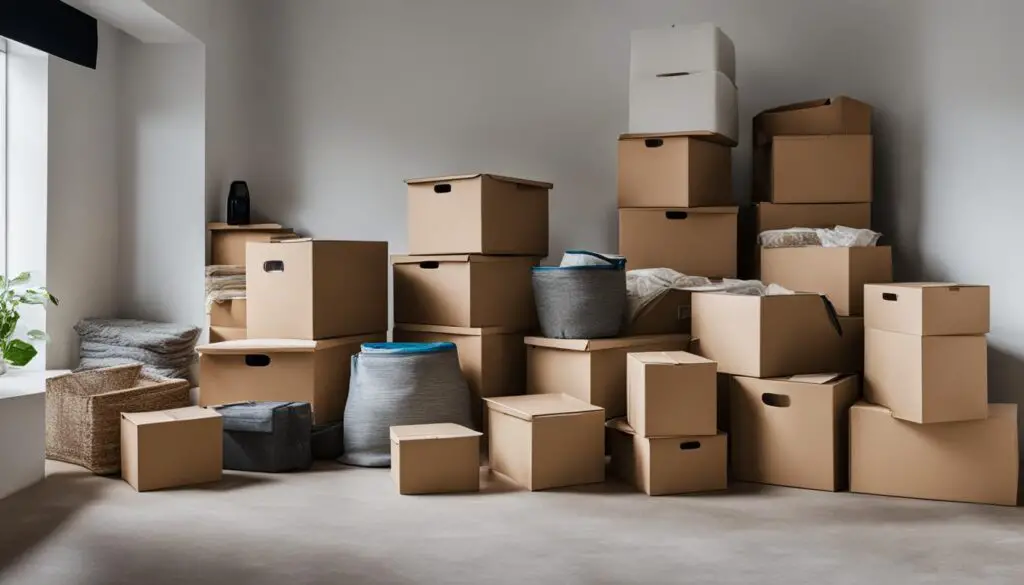Keeping Your Home Clean and Organized: A Family Approach
Maintaining a clean and organized home is essential for a peaceful and happy family life. From decluttering your living spaces to establishing efficient cleaning routines, there are several strategies that can help you achieve a tidy and well-managed home environment. In this article, I will share expert home organization tips, offer guidance on decluttering your home, and provide insights into creating effective cleaning routines. By involving the whole family and implementing organization hacks, you can enjoy a tidy living space that promotes productivity, relaxation, and harmony.
Key Takeaways:
- Maintaining a clean and organized home is possible with a family approach.
- Decluttering your home is essential for creating a more organized living space.
- Establishing cleaning routines helps ensure consistent cleanliness and hygiene.
- Involving children in household tasks teaches responsibility and contributes to a tidy home.
- Creating organized spaces with clear storage systems maximizes efficiency and minimizes clutter.
Reducing Clutter and Decluttering
One of the key aspects of maintaining a clean and organized home is reducing clutter. By regularly going through your belongings and clearing out items that are no longer needed, you can create a more organized living space. Decluttering not only helps create a visually appealing environment, but it also promotes a sense of calmness and reduces stress.
When decluttering, it’s essential to adopt a systematic approach. Start by tackling one area of your home at a time, such as a closet or a room. Sort through your possessions and categorize them into three groups: keep, donate, and recycle. Only keep items that you truly need or bring you joy.
Donating items that are still in good condition is a great way to give back to the community while reducing clutter. Identify local charities or organizations that accept donations and schedule regular trips to drop off your unwanted items. Recycling is another environmentally friendly option for disposing of items that can’t be donated.
By minimizing possessions, you can create more functional and spacious living areas. Consider the 80/20 rule: we typically use only about 20% of our possessions regularly. Take a critical look at the items you own and ask yourself if you truly need them. Letting go of unnecessary belongings not only frees up physical space but also has a positive impact on your mental well-being.
Organizing your belongings is another essential aspect of decluttering. Create designated spaces to store different categories of items. Use storage bins, boxes, and baskets to keep things neat and organized. Labeling containers can help you find things quickly and easily. When everything has its designated place, it’s easier to maintain a clutter-free home.
Here are some decluttering tips:
- Start small and focus on one area at a time.
- Set realistic goals and allocate time for decluttering.
- Ask yourself if an item is truly necessary or brings you joy.
- Consider the functionality and usability of each possession.
- Get rid of duplicates or items you haven’t used in a long time.
- Make decluttering a regular practice to prevent accumulation of unnecessary items.
“The space in which we live should be for the person we are becoming now, not for the person we were in the past.” – Marie Kondo
Remember, decluttering is an ongoing process. Regularly evaluate your belongings and make adjustments as needed. By adopting a minimalist mindset and organizing your belongings, you can create a more peaceful and clutter-free living environment.
Establishing Cleaning Routines
Creating a cleaning routine is essential for maintaining a clean and organized home. By establishing specific times for cleaning tasks, such as daily tidying and nightly kitchen cleanup, you can keep your home in a consistently clean state. It is also important to schedule weekly deep cleaning tasks, such as bathroom cleaning and vacuuming, to ensure that your home remains clean and hygienic. Setting time limits for cleaning tasks can help prevent them from becoming overwhelming and time-consuming.
Having a regular cleaning routine helps to keep your home in order and prevents dirt and clutter from accumulating. By breaking down your cleaning tasks into manageable daily and weekly routines, you can stay on top of your household chores without feeling overwhelmed.
Here’s an example of a daily cleaning routine:
- Daily tidying: Spend 10-15 minutes each day picking up clutter and putting things back in their designated places.
- Nightly kitchen cleanup: After dinner, wash the dishes, wipe down countertops, and sweep the floor.
Additionally, scheduling weekly deep cleaning tasks is crucial for maintaining a truly clean and hygienic home. These tasks should focus on areas that require more attention and may not be covered in your daily cleaning routine:
- Bathroom cleaning: Scrub the toilet, clean the shower and bathtub, wipe down surfaces, and mop the floor.
- Vacuuming and dusting: Vacuum carpets and rugs, dust surfaces, and wipe down furniture.
Benefits of Establishing Cleaning Routines
By establishing cleaning routines, you can experience several benefits:
- Maintain cleanliness: Regular cleaning tasks prevent the buildup of dirt, dust, and grime, ensuring a consistently clean living environment.
- Save time and effort: By breaking down cleaning tasks into manageable routines, you can avoid spending excessive time and energy on deep cleaning activities.
- Reduce stress: Knowing that you have a plan in place for maintaining cleanliness can alleviate stress and create a sense of order in your home.
- Improve overall hygiene: Deep cleaning tasks, such as bathroom cleaning and vacuuming, help eliminate germs and allergens, improving the overall hygiene of your home.
Consistency is key when it comes to cleaning routines. By sticking to a schedule and making cleaning a regular part of your daily and weekly activities, you can ensure that your home remains clean and organized.

Getting Children Involved in Household Tasks
Involving children in cleaning and household tasks is not only beneficial for parents but also teaches them responsibility and the importance of contributing to the family. By assigning age-appropriate chores, children can develop essential life skills and actively participate in the maintenance of a clean and organized home.
Teaching children responsibility through household tasks allows them to develop a sense of ownership and pride in their contributions to the family. It instills valuable skills such as time management, problem-solving, and teamwork. By involving children in cleaning and organizing, we are not only lightening the load for parents but also preparing them for a future where these skills will be essential.
When assigning chores, it is crucial to choose tasks that are appropriate for a child’s age and abilities. This ensures their safety and success in completing the tasks. Younger children can help with simple tasks like tidying up toys, making their beds, and setting the table. As they grow older, they can assist with more significant chores like dusting, vacuuming, and folding laundry.
A family economy system can further motivate children to participate in household cleaning. By introducing a reward system tied to chores, children can earn privileges or rewards based on their contributions. This can be in the form of pocket money, screen time, or special treats. The family economy system not only incentivizes children but also teaches them about the value of hard work and earning rewards through their efforts.
“By involving children in household tasks, we are providing them with valuable life skills and teaching them the importance of contributing to the family. It’s not just about cleaning; it’s about fostering responsibility and a strong work ethic.”
Children learn by example, so it’s essential for parents to lead by demonstrating a positive attitude towards household tasks. Encouragement and praise go a long way in motivating children to participate and take pride in their contributions. By involving children in cleaning and organizing, we are fostering a sense of responsibility and teamwork within the family.
Remember, involving children in household tasks is not only about getting the job done—it’s about teaching important life skills, promoting responsibility, and creating a positive family dynamic.
Age-Appropriate Chores for Children
| Age Group | Chores |
|---|---|
| 2-4 years | Tidying up toys |
| 5-7 years | Making beds, setting the table |
| 8-10 years | Dusting, sweeping, folding laundry |
| 11-13 years | Vacuuming, cleaning windows |
| 14+ years | Deep cleaning, mowing the lawn |
As children grow older, their capabilities and maturity level increase, allowing them to take on more complex tasks. Sit down with your children and discuss the importance of their contributions to the household. Encourage them to take responsibility and be proactive in completing their assigned tasks.
By involving children in cleaning and organizing, we are not only maintaining a clean and organized home but also imparting important life skills that will serve them well in the future. It’s a win-win situation for both parents and children.
Creating Organized Spaces
When it comes to maintaining a clean and organized home, having clear systems for storage and organization is key. By assigning each item a designated home and implementing clear systems for storage, you can prevent clutter from accumulating and create a tidy living space. This not only makes it easier to put things away but also maximizes storage space and ensures that items are easily accessible when needed.
One effective strategy for organizing belongings is to categorize them based on their function or type. This allows you to create logical groupings and makes it easier to find and retrieve items. For example, you can designate separate areas for kitchen utensils, office supplies, or children’s toys. By using bins, baskets, and other organizational tools, you can further enhance the clarity and efficiency of your storage systems.
| Organizational Tools | Benefits |
|---|---|
| Bins and Baskets | – Ideal for grouping smaller items together – Maximizes storage space – Provides easy access to items |
| Shelves and Cubbies | – Utilizes vertical space – Creates display areas for items – Keeps belongings organized and visible |
| Drawer Dividers | – Separates and categorizes items – Prevents items from becoming jumbled – Enhances drawer organization |
Maintaining tidy spaces also requires a commitment to regularly declutter and reassess your belongings. Periodically go through your items and consider whether they still serve a purpose or bring value to your life. If not, it may be time to let go and donate or recycle them. This practice not only helps to create physical space but also promotes a sense of mental clarity and well-being.
Overall, establishing clear systems for storage, categorizing belongings, and utilizing organizational tools can greatly contribute to maintaining an organized living environment. By incorporating these strategies into your daily routine, you can create a space that is both functional and visually appealing.

Conclusion
Maintaining a clean and organized home is crucial for creating a stress-free and harmonious living environment. By implementing the right strategies and involving the entire family, you can achieve a clean and organized home that is both functional and aesthetically pleasing.
Reducing clutter and decluttering regularly are essential for maintaining a clean and organized home. By organizing your belongings and establishing a system for managing new items, you can prevent clutter from accumulating and create a more organized living space.
In addition to reducing clutter, it is important to establish cleaning routines. By designating specific times for daily tidying and weekly deep cleaning tasks, you can keep your home consistently clean and hygienic. Setting time limits for cleaning tasks can also help prevent them from becoming overwhelming and time-consuming.
Getting children involved in household tasks not only helps lighten the load for parents but also teaches responsibility and important life skills. Assigning age-appropriate chores to children and implementing a family economy system can encourage their participation in cleaning and contribute to the maintenance of a clean and organized home.
Lastly, creating organized spaces with clear systems for storage is crucial for maintaining a clean and organized home. By designating a home for each item and maximizing storage space with the use of organizational tools, you can prevent clutter and make it easier to keep spaces tidy.
Remember, maintaining a clean and organized home requires consistency and effort. By following these tips and involving the whole family, you can achieve a clean and organized home, fostering a delightful and harmonious living space for you and your loved ones.
FAQ
How can I reduce clutter in my home?
You can reduce clutter by regularly going through your belongings and getting rid of items that are no longer needed. This includes donating or recycling items that are still in good condition but no longer serve a purpose in your home.
What are some tips for establishing cleaning routines?
To establish cleaning routines, you can set specific times for cleaning tasks, such as daily tidying and nightly kitchen cleanup. It is also important to schedule weekly deep cleaning tasks, like bathroom cleaning and vacuuming, to ensure that your home remains clean and hygienic.
How can I get my children involved in household tasks?
You can involve your children in household tasks by assigning age-appropriate chores to them. This not only lightens the load for parents but also teaches children responsibility and the value of contributing to the family. Implementing a family economy system, where children earn privileges or rewards for completing tasks, can further incentivize their participation in household cleaning.
What can I do to create organized spaces in my home?
To create organized spaces, each item should have a designated home where it belongs when not in use. This helps prevent clutter and makes it easier to put things away and keep spaces tidy. Additionally, maximizing storage space and utilizing organizational tools, such as bins and baskets, can help create an organized and functional living environment.
How can I maintain a clean and organized home?
To maintain a clean and organized home, it is important to follow the strategies mentioned earlier. This includes reducing clutter, establishing cleaning routines, getting children involved in household tasks, and creating organized spaces. With consistency and effort, it is possible to maintain a clean and organized home, fostering a delightful and harmonious living space.






